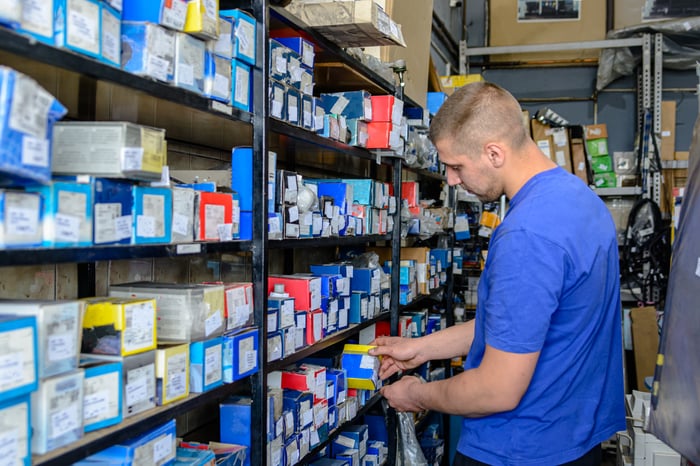2 Green Flags for AutoZone Stock, and 1 Red Flag to Watch

Key Points
AutoZone continues to expand its store count.
The stock has outperformed the broader market.
Slowing growth could be a problem.
AutoZone (NYSE: AZO) stirred some investor nerves recently after its latest earnings report, but the fundamentals still offer promising reasons to pay attention.
Let's dig into two green flags in favor of owning AZO -- and one clear red flag that tempers the bullish case.
Where to invest $1,000 right now? Our analyst team just revealed what they believe are the 10 best stocks to buy right now. Continue »
Green flag 1: Growth via expansion, not just the status quo
Even as same‑store sales growth moderates, AutoZone is leaning into expansion as a lever for future upside. In its most recent quarter, the company opened 141 net new stores globally. Over the full fiscal year, AutoZone added 304 net new locations, bringing its total footprint to 7,657 stores. That kind of expansion investment sends a message: Management is not conceding to slowdowns, but is doubling down on scale and reach.
And the same‑store metrics, though under pressure, have held up reasonably well. Total company same‑store sales rose 5.1 % in the quarter (or 4.5 % on a consistent accounting basis), with domestic comps of 4.8 %.
Growth may be decelerating, but AutoZone is still putting capital to work to expand its footprint -- a signal that leadership expects that there's still market share and territory to win.

Image source: Getty Images.
Green flag 2: Performance track record that outpaces the broader market
For long-term investors, AutoZone has delivered very favorable returns. Over the past five years, the stock has gained 271%, while the S&P 500 (SNPINDEX: ^GSPC) was up 101%. That kind of outperformance tends to build investor confidence, even when periodic quarters look shaky.
One attractive characteristic is that AutoZone addresses a piece of "inelastic demand." Car maintenance is not always optional. In periods of tariff risk or supply‑chain pressures, consumers still need parts, even if costs rise.
I view AutoZone as a partial hedge in inflationary or tariff‑heavy environments, since consumers must choose between maintaining a vehicle or giving up mobility. That said, margins will feel the pressure of those cost increases.
Put differently: Even in turbulent times, AutoZone's stock has shown resilience and a capacity to reward long-term holders.
Red flag: Slowing growth and declining profitability metrics
This is where the case gets more nuanced. While growth is persistent, its rate is clearly decelerating year over year -- and some margin metrics are slipping.
Slower revenue growth
Historically, revenue top-line gains were much stronger:
- 2021: 15.81 %
- 2022: 11.09 %
- 2023: 7.41 %
- 2024: 5.92 %
Now, for fiscal year 2025, net sales barely rose 2.4 % to $18.9 billion.
Operating income fell 4.7 % to $3.6 billion; net income declined 6.2 % to $2.5 billion; and diluted earnings per share slid 3.1 % to $144.87. In the quarter, operating profit was down 7.8%, and net income fell to $837 million (EPS: $48.71).
Part of the pressure is from rising costs, including a noncash LIFO charge that shaved gross margin (~128 basis points) in the quarter. Also, operating expenses increased as a percentage of sales (32.4% vs. 31.6% prior). The risk is that this trend continues, since slower revenue growth, squeezed margins, and increased competition could make it harder for AutoZone to match the compounding growth rates of prior years.
So is AutoZone a buy?
AutoZone still has serious positives working in its favor: a deliberate expansion strategy and a track record of outperforming in the broader market. Those are meaningful green flags for investors seeking exposure to stable consumer infrastructure.
But the red flag is hard to ignore. Growth is cooling, and margins are under strain. If those trends worsen or persist, the stock's upside becomes more precarious.
For investors considering AZO, the proper question might be: How much premium am I willing to pay for a company with a slowing trajectory? If expectations are rooted in "business as usual," any further softening could disappoint.
Should you invest $1,000 in AutoZone right now?
Before you buy stock in AutoZone, consider this:
The Motley Fool Stock Advisor analyst team just identified what they believe are the 10 best stocks for investors to buy now… and AutoZone wasn’t one of them. The 10 stocks that made the cut could produce monster returns in the coming years.
Consider when Netflix made this list on December 17, 2004... if you invested $1,000 at the time of our recommendation, you’d have $651,593!* Or when Nvidia made this list on April 15, 2005... if you invested $1,000 at the time of our recommendation, you’d have $1,089,215!*
Now, it’s worth noting Stock Advisor’s total average return is 1,058% — a market-crushing outperformance compared to 188% for the S&P 500. Don’t miss out on the latest top 10 list, available when you join Stock Advisor.
*Stock Advisor returns as of September 22, 2025
David Butler has no position in any of the stocks mentioned. The Motley Fool has no position in any of the stocks mentioned. The Motley Fool has a disclosure policy.







